
7 Mistakes Everyone Makes When Cleaning Wood Furniture
Are you unknowingly damaging your beloved wooden furniture? Learn the common cleaning mistakes that are secretly ruining your wood furniture.
By:
The Good Home Daily
Posted on October 14, 2025
You love your wood furniture. It’s an investment, a timeless piece, or maybe a family heirloom passed down through generations. You want to take care of it, and you probably think you’re doing a good job. But what if the very products and techniques you’re using to clean your wood furniture are secretly ruining it?
Many people unknowingly make common wood furniture cleaning mistakes that can lead to irreversible damage. The good news is, these mistakes are easy to fix once you know what they are.
In this guide, we’ll uncover the most common blunders in wood furniture care to help you maintain your wood furniture the right way. Some of these will surprise you.
Why Your Wood Furniture is More Vulnerable Than You Think

One study found that 65% of people don’t read cleaning product labels before use. That’s risky, as some chemicals can seriously damage furniture, especially the wood.
Wood has a natural charm that makes it a favorite in Filipino homes, from living room pieces to outdoor furniture. However, part of its appeal is also what makes it fragile.
Being a porous material, wood has tiny fibers and grains that absorb moisture and react to changes in temperature and humidity. So, even simple cleaning mistakes can leave lasting damage.
In fact, research shows that cleaning and disinfecting chemicals used in municipal facilities—like swimming pools and water treatment plants—cause the degradation of several types of wood. If harsh products can do that to large structures, imagine what they can do to your furniture.
What’s more, different woods have different sensitivities. Narra, kamagong, and molave are hardwoods known for their durability, yet they can still lose their finish if exposed to strong cleaners.
On the other hand, softer woods like tanguile, yakal, or gmelina are easier to work with and more affordable, but they’re prone to scratches, dents, and stains if not handled with care.
As for plywood, it’s a practical choice for furniture and home projects, but it needs extra protection from moisture. Without proper sealing, its layers can swell or peel apart over time.
Finishes also add another layer of complexity. Varnish, lacquer, or natural oils can highlight a wood’s beauty, but once they wear down, the raw surface underneath becomes exposed. At that point, wood absorbs liquid faster and is more likely to crack or fade.
And not all finishes behave the same. Polyurethane is generally more forgiving than lacquer or oil. Waxed pieces require an entirely different approach compared to sealed ones. Yet most people still use the same cleaning method on every piece of furniture they own.
7 Most Common (and Costly) Wood Furniture Cleaning Mistakes
Many people damage their wood furniture without realizing it. Here are the most common wood furniture cleaning mistakes you might be making, and what to do instead.
1. Using Too Much Water

Wood might look solid, but it soaks up water like a sponge. When you introduce excess water during cleaning, you’re forcing rapid moisture absorption that the wood can’t handle gracefully.
Too much moisture causes swelling, stains, or even warping. Even wiping with a soaked rag can leave behind water rings. These marks can become permanent and require professional restoration.
The right way: Your cleaning cloth should be barely damp. If you can wring water out of your cleaning cloth, it’s too wet. Also, make sure to wipe the surface dry right after.
2. Skipping the Dusting Step
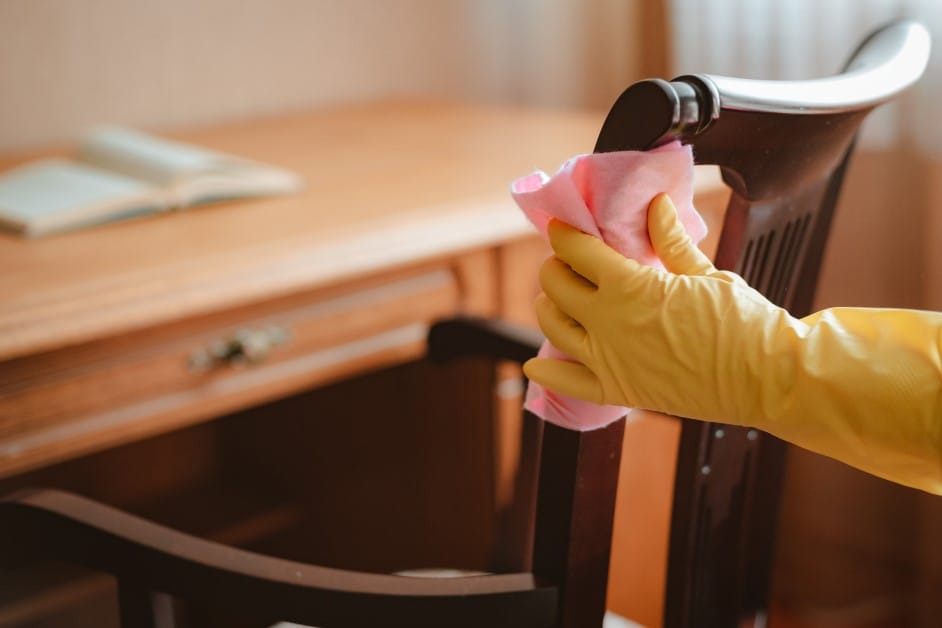
This is perhaps the most underestimated wood furniture maintenance mistake. Dust is abrasive. Each tiny particle can scratch the surface when wiped away carelessly.
So, when you skip dusting, you’re essentially creating sandpaper paste that creates micro-scratches on the surface of your wood.
The right way: Dust your furniture every week. The best way to dust wood without scratching is to use a high-quality microfiber cloth. This material traps dust instead of spreading it around.
Dust your furniture every week. The best way to dust wood without scratching is to use a high-quality microfiber cloth. This material traps dust instead of spreading it around.
3. Choosing the Wrong Cleaning Products
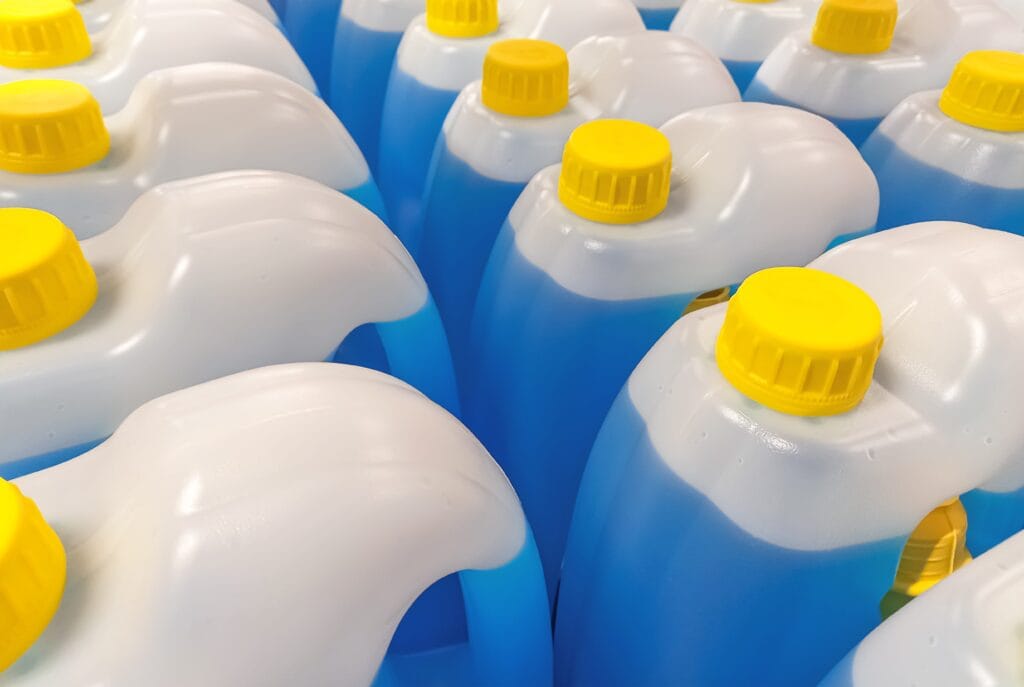
This may sound simple, but is it really? Using all-purpose cleaner is one of the biggest mistakes you can make when cleaning wood furniture. Ammonia-based products, in particular, can react with certain stains and finishes, leading to permanent discoloration.
Similarly, using alcohol directly to kill germs might seem harmless, but it can dry out the wood and damage its coating over time. Since wooden furniture such as desks are common germ hotspots
, it is important to clean them gently but effectively.
The right way: Avoid cleaners with ammonia, bleach, or silicone. Stick to cleaners specifically formulated for wood furniture, or use a very mild, pH-neutral solution.
You can also mix your own mild solution: 2–3 drops of dish soap in a cup of water. Dampen a soft cloth with it, wipe gently, then dry immediately with another cloth.
4. Spraying Your Cleaner Directly on Wood Furniture
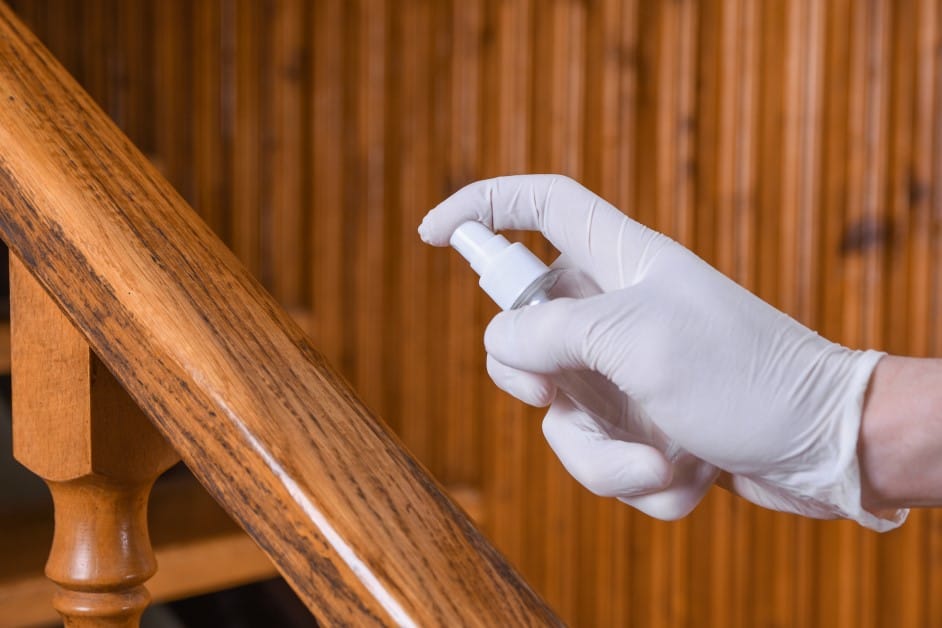
Using the wrong cleaner is one mistake. Spraying it directly on wood is another. And, both can damage your furniture.
Never spray cleaning solution directly onto wood furniture. Liquids can seep into seams, joints, or scratches, causing swelling, stains, or a sticky residue that attracts more dust.
The right way: Always spray the cleaner onto a microfiber cloth first, then wipe the surface. This gives you control over how much liquid touches the wood.
5. Using Pure Vinegar as a Cleaner
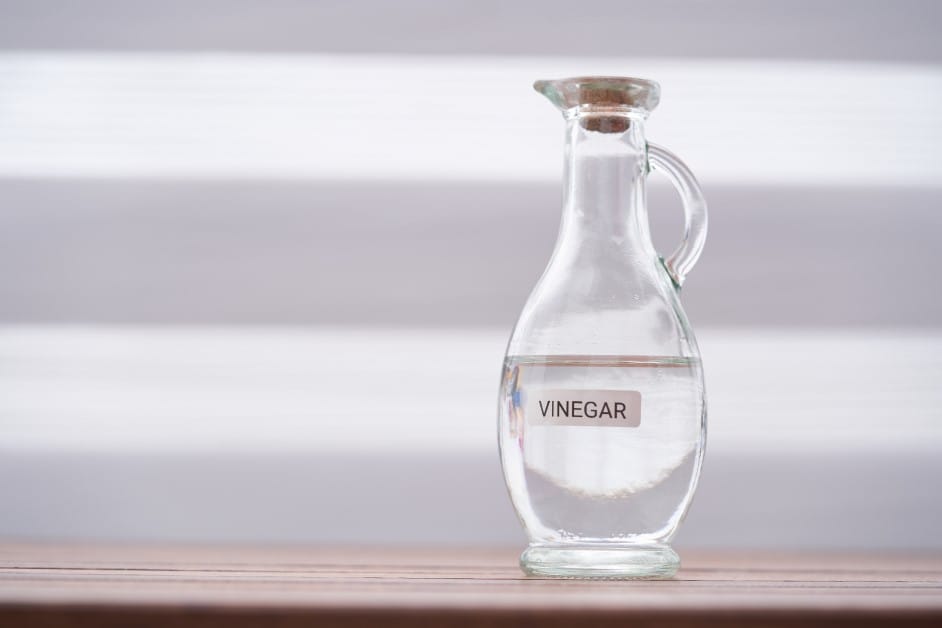
Vinegar is one of the most popular DIY cleaning ingredients. It works wonders on glass, microwaves, and even countertops. But on wood, pure vinegar is too harsh. Its high acidity can strip away finishes, dull the shine, and even weaken protective coatings over time.
The right way: You can use vinegar to clean wood furniture. But, always dilute it heavily with water—about a 1:10 ratio. We also recommend testing it on a hidden area first. Better yet, stick to cleaners made specifically for wood to keep your furniture safe and long-lasting.
6. Scrubbing with Abrasive Materials
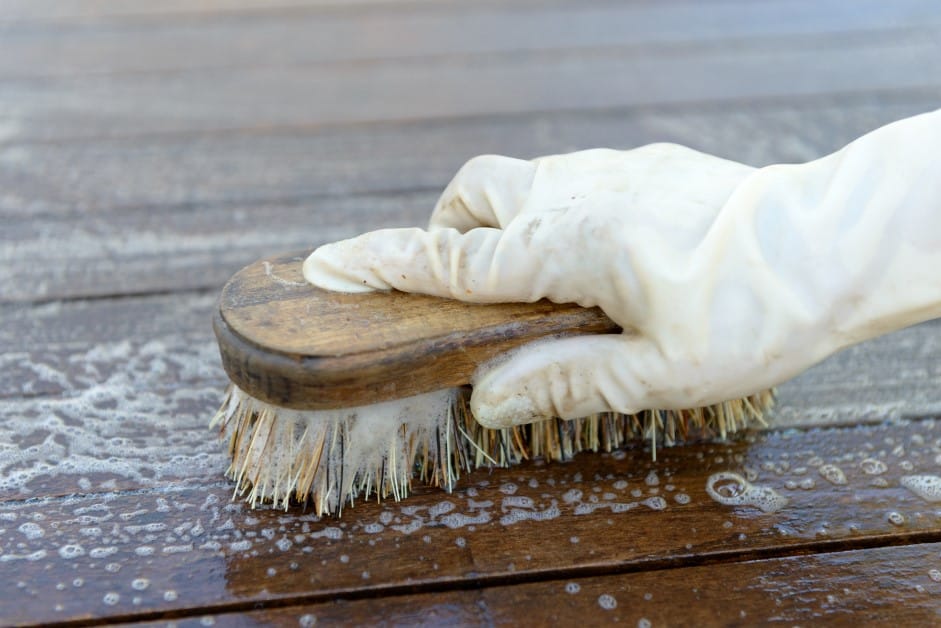
Avoid using steel wool, scouring pads, or even rough sponges to tackle stains or sticky spots. Even paper towels may seem harmless, but their fibers can still scratch delicate wood finishes.
Using these materials is a surefire way to create permanent, deep scratches in your furniture’s finish. They can cut right through the protective layer, potentially damaging the wood itself.
The right way: Stick to microfiber cloths when cleaning wooden furniture. For stubborn stains, reach for a wood-safe cleaner or polish instead of scrubbing.
7. Over-Cleaning and Over-Polishing

More cleaning equals better maintenance, right? Wrong!
Too much cleaning or polishing can actually weaken your wood furniture. Over-cleaning strips away the natural oils and protective finish, making the wood more vulnerable to dryness, cracks, or fading. Over-polishing, on the other hand, builds up a sticky layer that attracts dust and dulls the shine.
The right way: Dust regularly and deep clean only when necessary. Most wood furniture needs polishing only 3-4 times per year.
Clean Your Wooden Furniture the Right Way
Taking care of your wood furniture doesn’t have to be complicated. By avoiding these common cleaning mistakes, you can easily preserve the beauty and longevity of your pieces.
Remember the golden rule: be gentle. Use a soft cloth, the right cleaners, and a light touch. A little consistent wood furniture care goes a long way in protecting your cherished items.

